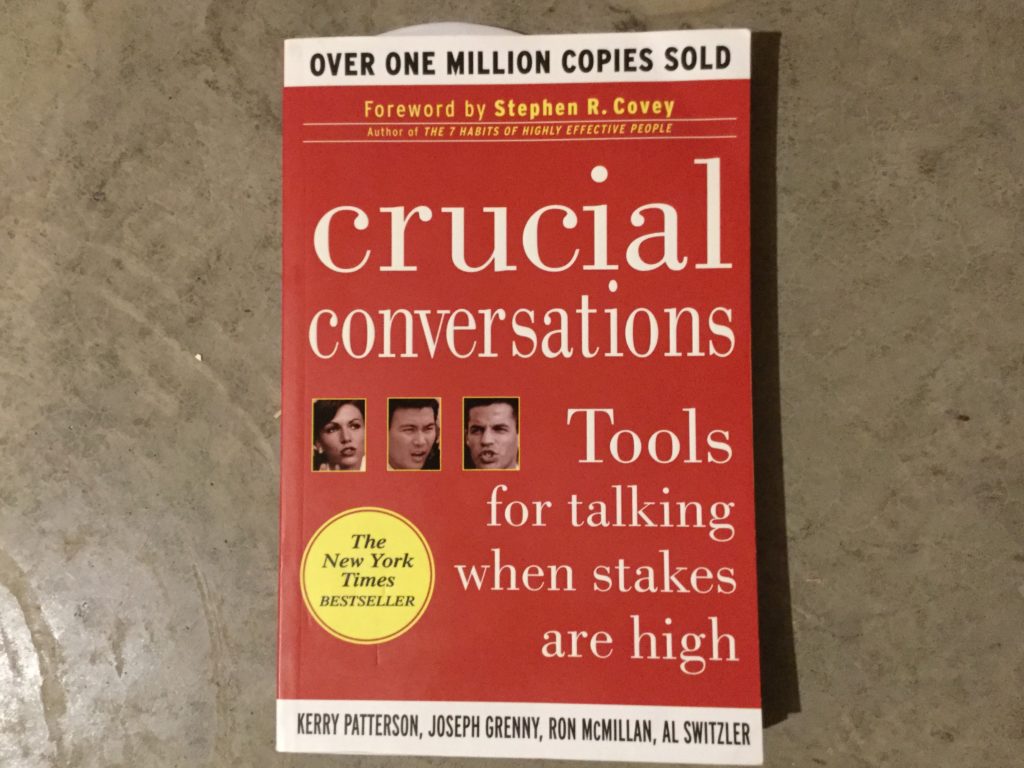Notes from Crucial Conversations
 By Jesse Jost
By Jesse Jost
I just finished reading “Crucial Conversations: Tools for talking when the stakes are high” By Kerry Patterson, Joseph Grenny, Ron McMillian, and Al Switzer. The book was a wise and practical read on learning how to have conversations that reflect the love-fuelled dialogue the apostle Paul pleads with the church to have.
I was so impacted, convicted, and inspired by the book, that I unrealistically want everyone to read it. Of course hardly anybody has the time to read or follow up on book suggestions, so I took the time to distil the principles in the book into an article format.
I hope this short piece inspires you to buy the book for yourself, but more importantly, helps transforms your ability to speak the truth in love, with wisdom and compassion.
————————————————–
A crucial conversation = when emotions become involved and the outcome of the conversation will have an impact on direction or quality of life. Your ability or inability to handle these types of conversations will have a tremendous effect on the quality of your relationships and success at work or in your organization.
When emotions run high, blood is directed away from our higher brain functions and toward our fight or flight system. As emotions rise, we tend to fall back on to habits of silence or violence, becoming less mentally equipped to handle the complex issues before us.
The goal of healthy dialogue is the free exchange of information, opinions and feelings. This is only achievable when trust is earned through creating a safe environment. Feeling safe is absolutely critical.
Here are 7 conversation skills you can develop to navigate crucial conversations effectively.
Skill #1 Start with the Heart
Before a conversation you must decide what you really want, and not waver from the goal. Often we get distracted when conversations become heated and we resort to wanting to win an argument, justify ourselves, or prove a point.
Be aware of the Sucker’s Choice: a) Speak the truth bluntly and not care about who gets hurt, or b) stay quiet and not hurt feelings. Neither option contributes to the “pool of shared meaning.” The first makes people defensive so they can’t hear what we are saying, and the second doesn’t allow people to know how we really feel.
Skill #2 Learn to Look
A skilled conversationalist notes not only the content of the conversation, but also the conditions. When you become aware that others are shutting down or getting upset, you need to pause the conversation and recreate a safe environment.
Learning to look is an acquired skill. People often become so focused on the content – the point they want to make – that they become blinded to the conditions – whether people are receptive or not.
People often respond in silence (withholding their honest ideas) as shown by their withdrawing, masking, or avoiding. Or they respond in violence as shown by controlling, labeling, or attacking.
Skill #3 Make it Safe
When emotions are high and people are shutting down, it is imperative to regain trust and a feeling of safety.
This can be achieved by:
Apologizing:
Humbly admit when you have made a mistake or been harsh. Admission of wrongdoing shows sincerity in your desire to achieve open dialogue.
Contrasting:
Sometimes it helps to be upfront about what you are not saying, especially if the other person is already on edge. Use phrases like: I want to be clear, I’m not trying to… I am trying to…(clarify your goal, the heart of your message).
CRIB
Here are four more ways to regain trust and safety and keep the dialogue moving forward:
Commit to seek mutual purpose
People need to feel this conversation has both people’s best interests at heart and is not just for the benefit of one side.
Recognize the purpose behind the strategy
Sometimes it seems that each side’s strategies, their outward actions, are at odds, but sometimes there is a compatible purpose underneath.
Invent a mutual purpose
Try to discover how the deeper desires mesh, how both sides can achieve what they really want.
Brainstorm new strategies
Once emotions have cooled down, you both should be able to step back and explore ways that both desires can be met, albeit with some compromise.
Skill # 4 Master My Stories
Our emotions are an automatic response to the story we tell ourselves in order to interpret the facts. To regain control of our emotions, we must question our story. We also need to differentiate between the facts and our stories (our interpretation of the facts).
Three Clever (but Damaging) Stories:
The Victim Story
We feel absolved of any way we contributed to the problem.
The Villain Story
We assume evil or ignorant motives on the part of the other person and place all the blame on them.
The Helpless Story
When we justify ourselves as innocent, and place all the blame on the other person, we are left with a feeling of helplessness.
Three Useful Stories:
Turn Victims into Actors
Take an honest look at how you may have contributed to the problem.
Turn Villains in Humans
Question your assumption of evil motives. Reinterpret the facts by asking, “If this person were wise, kind, and rational, why would they do the actions in question?” It may turn out that the other person did have evil motives, but questioning the story allows us not to be so blinded by emotion.
Turn the Helpless into the Able
Ask again, “What do I really want? And what can I do to achieve it?”
Skill # 5 STATE your path.
Your interpretation of the facts – the story you told yourself – took you on a path toward your current emotional state. You need to carefully share your perspective and why you are feeling what you feel.
Share your facts
Start with the obvious facts before moving to your interpretation of them.
Tell your story
Explain how you see the facts and your story – how you interpreted them.
Ask for others’ paths
Give the other person a chance to explain their rationale and how they saw and interpreted the same facts.
Talk tentatively
To encourage healthy dialogue, you must speak with understatement and an acknowledgement of your own infallibility. If you speak with confident accusations and dogmatic assertions that the other side is wrong, you will shut down conversation.
Encourage testing
You need to honestly demonstrate your willingness to learn and be corrected and to hear how things looked from the other side, even if it is embarrassing and painful.
Skill #6 Explore others’ paths
You need not only to make sure your perception is expressed, you need to carefully tease out what the other person really thinks and feels. This can be done in 4 ways:
AMPP
Ask
Start by gently inviting the other person to share.
Mirror
Let them know how their actions and emotions are coming across to you.
Paraphrase
Restate in your own words what you understand that person to be saying and ask if you understand them correctly.
Prime
If you still feel like the other person is holding back and not opening up, offer some possibilities the other person may be struggling with and see if that opens them up.
Skill # 7 Move to Action
Clarify expectations about who will make the decision and who will do what. Discern if this is a Command decision, or needs a Consultation, Vote, or Consensus decision.
Related:
Breakdown: A Demon’s Guide to Communication
